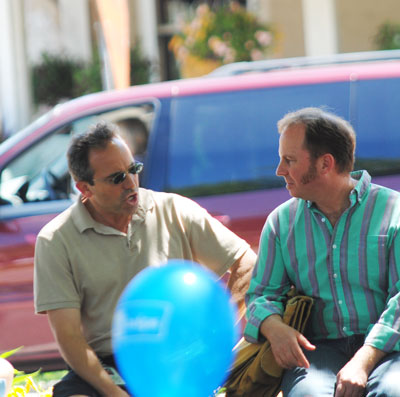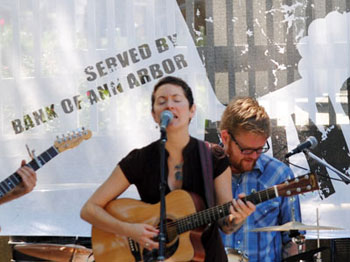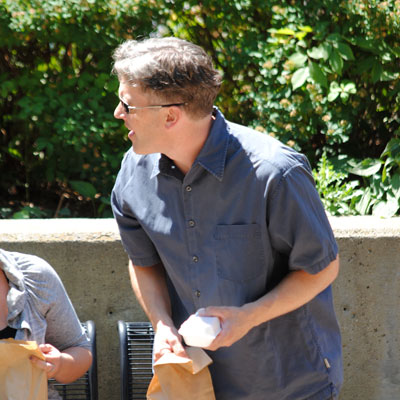Photos: Scenes from Ann Arbor’s Sonic Lunch
If you’re in downtown Ann Arbor around noon on Thursdays, there’s a good chance you’ll at least stroll by Liberty Plaza for Sonic Lunch, a free summer concert series featuring local musicians.
This week, Misty Lyn & The Big Beautiful – including Jim Roll on bass, Matt Jones on drums, Carol Gray on fiddle and tambourine, and Ryan Gimpert on guitar – filled the plaza with a soulful, folk-rock sound.
But part of the show for these lunchtime events is always the crowd itself. The Chronicle was there taking photos, and spotted many familiar faces – how many people do you know, too? We’ve supplied fake quotes in some of the captions to help with the challenge.
Cracked slab segue alert: Readers who attended the Sonic Lunch on Thursday will probably have arrived there by foot, more specifically by walking along a sidewalk. Sidewalks are one focus of a very short survey being conducted by the city of Ann Arbor. Take it here: Sidewalk survey.

Misty Lyn & The Big Beautiful, from left: Ryan Gimpert, Misty Lyn, Matt Jones, Carol Gray, Jim Roll.

1. "Why yes, one of the prices paid for celebrity is being stalked by paparazzi – and there'll be more of them at Top of the Park when I play tonight."

2. "The color on that guy's T-shirt back there reminds me: Need to revise maps indicating concentration levels for the spread of the Pall dioxane plume."

4. "I don't think this plaza is zoned for balloons – they probably need a special use permit." "I dunno, they look like they're filled with helium ... my specialty is more water balloons."

6. "My job is to be hard-headed about parks. I don't need no stinkin' hard hat on top of that." "Sorry, gotta go ... cement mixers are music to my ears."

8. "If I grow up to be a lawyer, I'll have to wear a tie when I go to work. If I grow up to be a journalist, there won't be any work to go to. Either way, my neck feels itchy."
Purely a plug: The Chronicle relies in part on regular voluntary subscriptions to support our coverage of local government and civic affairs – and the occasional playful photo essay. Click this link for details:Subscribe to The Chronicle. And if you’re already supporting us, please encourage your friends, neighbors and colleagues to help support The Chronicle, too!









Since you brought it up, here’s a comment on the city’s sidewalk maintenance proposal.
While I do think the city should maintain their own sidewalks and I thought this proposal was a good idea at first, that changed after I did the math. It just does not make any sense for the city to charge us that much to take on sidewalk maintenance.
I just had to replace 6 sidewalk slabs last month at a cost of around $150 per slab. That “average” annual cost increase of an additional $227 is about the cost of having 1 1/2 slabs replaced in front of your house EVERY YEAR.
The slabs that I had to replace were a minimum of 70 years old (and not in terrible shape) and I have a total of around 25 slabs in front of my house. Even if I have to replace every sidewalk slab every 50 years, that would only cost me $3,750. Over that same 50 years the city would conservatively be charging “the average” homeowner” $11,350 (with no property value increases factored in). That is not a very good deal.
Our fair city trying to slide by yet another tax increase under the guise of “doing the good citizens a favor.” I wouldn’t have realized this if I hadn’t just had the slabs replaced. Don’t fall for it.
Dear Casey,
Sometimes even the best efforts by the City go awry. That’s so in this case — the survey provides the information about the proposed millage, but can easily confuse.
The average amount, for an average house, is $214 — and to extend the street millage would mean that you continue paying what you are paying now to maintain streets.
The would cost an addition $13 per year. It would take over 10 years of paying in to equal the amount you spent to replace one slab.
I’m sorry that this survey explanation was confusing. I hope you will consider continuing the street maintenance millage. (The City maintaining the streets, which is why it takes me so long to get downtown now, and last year made Plymouth Road impassible.) I also hope you will seriously consider supporting the sidewalk millage. (The City is also making certain all the sidewalk slabs still in need of replacement are being replaced, at the expense of the property owner.)
Thank you for reading the Chronicle.
Lost some words there. Second paragraph:
The sidewalk millage would cost an additional $13 per year.
PJ loves that he’s on the internet. The only problem is he stares at the picture intently and waits for himself to move.
For the record, I believe the city should stay out of sidewalk maintenance and it should continue, as it always has, to be in the hands of individual property owners.
First, I love the fact that this comment thread has primarily related to the sidewalk issue. That’s so…Chronicle.
Here’s a list of names to go with the faces in our photos. Thanks to everyone for being good sports!
1. Local musician Chris Bathgate.
2. Tim Berla (in red T-shirt), a local musician and member of the Ann Arbor park advisory commission, with Roger Rayle, leader of Scio Residents for Safe Water and an advocate for the cleanup of the Pall-Gelman 1,4 dioxane underground plume.
3. Brett Lenart, the Washtenaw County staff member who manages the county’s brownfield redevelopment program.
4. City planner Jeff Kahan (left) with Jerry Hancock, the city of Ann Arbor’s stormwater and floodplain programs coordinator. Hancock is also a local musician, best known for being a member of the band Corndaddy.
5. Shannon Brines of Brines Farm in Dexter. He’s also a member of the Ann Arbor public market advisory committee.
6. Tim Berla (see #2) and Adrian Iraola of Park Avenue Consultants, which is overseeing the construction of the underground parking structure on South Fifth Avenue.
7. Marsha Chamberlin (right), president of the Ann Arbor Art Center and chair of the Ann Arbor public art commission.
8. Jim Carty (left) with his son PJ. Carty is a former Ann Arbor News sports columnist who’s now an attorney with the law firm Bodman, working in their Ann Arbor office.
Regarding Sidewalks (millage or not): I’ve noticed some sidewalks include retaining walls in the concrete structure. This was included in handicap ramps recently installed along Summit Street at Spring, and at Daniel; also many other locations around town after a brief survey, not just at corners either. The walls at Daniel extend quite a few slabs to the north, and look to have been replaced for the sake of the wall, not the handicap ramp.
So, who is currently paying for these? And if the city takes over, how can I get them if I want them? I’m sure for the most-part it has been the homeowners responsibility, but it needs clarification who has paid for some of these corner sidewalks currently and in the past.
Thirteen dollars more a year in millage is well worth it to me, not so much for monetary reasons but for avoiding the hassle. A couple of years ago we replaced one sidewalk slab for, I think, about $125. However, the time spent going to the information sessions held by the city to make sure we knew what was required, finding a contractor, deciding what would be involved in partnering with my neighbors to hire someone together to lower the price, all added up to a lot of time. Then, for most of the summer you would see a cement mixer on your block pouring a slab and then 2 days later another cement mixer pouring another slab 2 doors away. Then the city inspector crisscrossing the neighborhood inspecting the sidewalk bit by bit as it was done. This seems inefficient to say the least. The city can hire a contractor to proceed in a more organized way. As far as getting together with neighbors to hire someone to do the work, we already have a group designed to do just that – it is called city government. The sidewalks are public thoroughfares and should be maintained with public money.
Re #7: I’ve noticed these walls here and there too. They seem to be constructed where the sidewalk previously led to a set of steps down to the street. Construction of the retaining walls where a high rampart was allows a gradual slope down to the ramp and eliminates steps. I think they are pretty nifty. Presumably they are part of the cost of the retrofits to fit accessibility issues. Maybe from transportation funds?
Yes, I’m pro-millage.
#7 Vivienne: The one at Spring & Summit includes a bump up on the street side of the sidewalk, to make a well for a tree, not to accommodate the grade of the hill. That is gardenscaping, not for the enabling of the disabled. Maybe there are codes and regulations about these, it’s all new to me.
My garden could use such a thing, but my sidewalks are new, so the answers do not effect me — I’m just curious for informations sake.
Cosmonican, I’ve also observed a few spots where very tasteful sculpting was done that included entries to the sidewalk leading to the house, or along the driveway, or whatever, so I agree that some of this seems to be discretionary improvement. Love to know the answer.